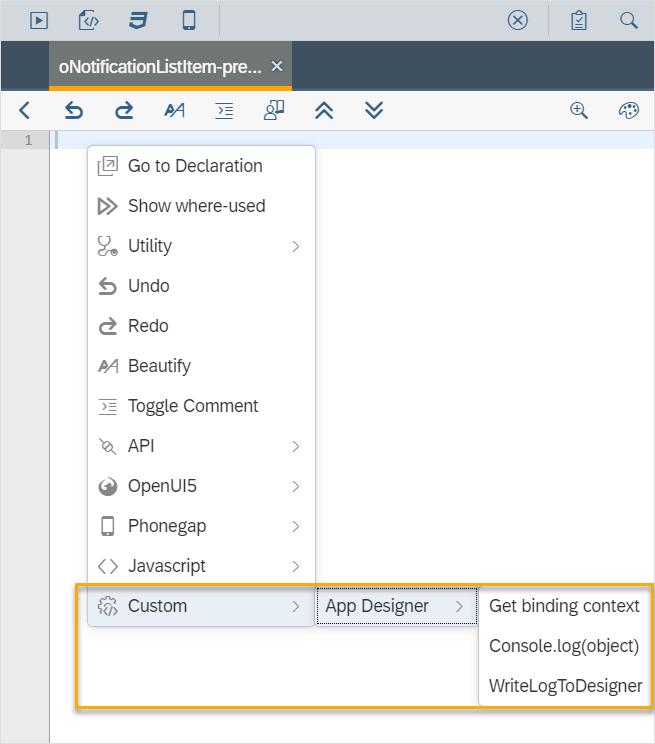Design best practice
This document is intended to list our combined project experience together with basic design guidelines to give beginners and advanced Neptune DXP - Open Edition developers guidance on how to design and structure your app(s) with the Neptune DXP - Open Edition.
As a start, we would like to emphasize the following basics:
-
Single point of entry is the Cockpit, which is the home page and central location of all Neptune DXP - Open Edition tools.
-
A launchpad can be downloaded from the Neptune DXP Marketplace to launch apps.
-
It is also possible to deploy and run each Neptune DXP - Open Edition application individually and stand-alone.
-
We recommend designing all UI5 apps stateless.
-
We recommend designing your apps as split-apps, using the App Designer. The following design best practices are a recommendation and do not necessarily include all relevant guidelines for a project.
App settings
-
We recommend using the standard
Belizetheme by default. Design adjustments can be added by applying custom CSS properties directly in the Theme Designer. -
We recommend defining the
Title/Groupattribute in your app settings as this is the wording that is displayed on the browser tab.
App basics
-
Every app should start with the
sap.m.Shellcontrol, which is typically namedShell. -
Beneath
sap.m.Shell, always place thesap.m.Apporsap.m.SplitAppcontrol as a sub-node. You should add theSplitApptemplate while creating an app. TheApp/SplitAppcontrol is the de-facto root control of your app that controls all navigation and busy-state of your app. For example, you can name itApp. You can have multipleApp/SplitAppcontrols under one shell. -
As sub-nodes to the
App/SplitAppcontrol, it is recommended to define a set ofsap.m.Pagecontrols that determine the needed screens of your app. Hierarchically, all pages should be placed at the same level. It is possible to navigate from one page to another throughout the app. -
The page control should be the first sub-node of your
App/SplitAppcontrol. It is the starting page which is displayed when the app starts. -
If you are adding a
SplitApptemplate, you need to specify thepositionparent-property in the attribute section of your page controls. You have to define if a page is shown in theMasteror theDetailsection of yourSplitApp.
Naming conventions
-
Every object of an app must have a unique name.
-
We recommend the following notation: starting uppercase and using uppercase letters for all leading characters of the composite name.
-
We recommend the following naming composition: Obj + Purpose + [Action]
-
In the HTML5 hierarchy,
Pagesshould be the leading controls on naming. -
As an example, if you design a page with the name
PageCustomerData, any sub-node to this page should follow the following naming:-
sap.m.Table:TabCustomerData -
sap.m.Button:ButCustomerDataSave -
sap.m.Button:ButCustomerDataBack
-
-
Rule of thumb: Define a naming convention at the beginning of a project and do not change it.
-
Do not just use UI5 names with numbers for your objects.
-
Name your
sap.m.ShellcontrolShell. -
Name your
sap.m.App/SplitAppcontrolApp.
Look and feel
-
As a rule, the design of your app should be based on
sap.m.Pageas your primary design container. -
Every page should include a header section.
-
Every page should include a footer section.
-
All process-specific design, for example, forms, tables, tabs, should be placed between the header and footer of a page.
-
The necessary process triggers, like buttons to save, cancel, submit, should be placed in the right section of the footer.
-
Back buttons should be placed in the left section of the page header or footer. It is important to stay consistent throughout your app(s).
-
In a
SplitAppenvironment:-
The master page should be the leading function, providing, for example, a list of (searchable) items, or an input form to define or search for datasets, or a list of subfunctions.
-
The detail page should display process or data details and functional triggers, for example, information on a specific dataset selected on the master page, sub-items of a dataset, or input fields to create a new dataset.
-
Both sections should have a footer, displaying buttons to trigger further actions.
-
-
Buttons should follow a basic color concept, which can be set via the property type:
-
Blue (type: Emphasized): Core function trigger of a page, for example, Search, Submit. In general, used to emphasize a particular button object in contrast to no styled buttons on the same footer or toolbar.
-
Green (type: Accept): Positive function trigger, used mostly in combination with a negative trigger, for example, Save or Delete.
-
Red (type: Reject): Negative function trigger, used mostly in combination with a positive trigger, for example, Decline or Approve.
-
None (type: default/none): Used for standard functions. Button blends in with footer/toolbar, for example, Settings.
-
API calls
-
To successfully design an API call, you need to define the following parts:
-
Bind your corresponding app controls to the model source.
-
In online scenarios, we recommend that you use the main receiving UI5 controls to bind with the API. For example, if you want to fetch a table data from the API, bind the API method with the corresponding UI5 control in which you want to get the table content.
-
In offline scenarios, the binding concept is working in the same way as in online situation scenarios.
-
-
If you want to use one data modal among the application, use multimodel binding, which allows you to use one data model source among multiple application objects.
-
